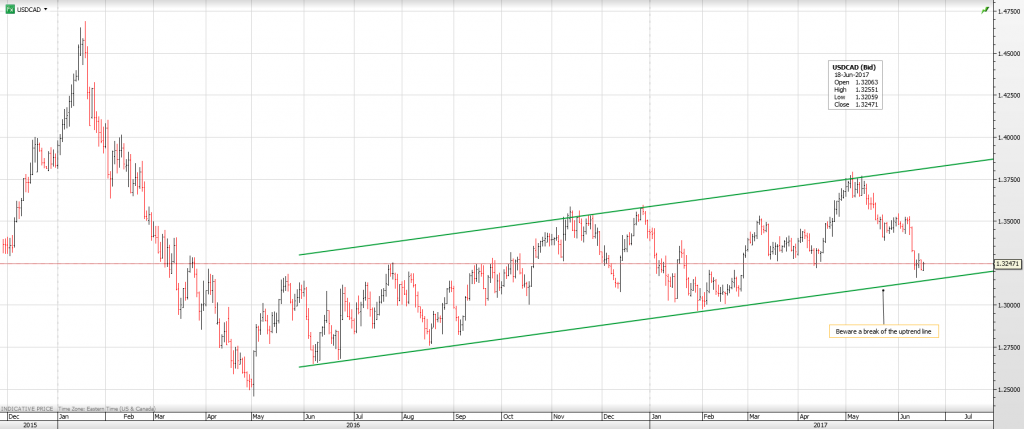USDCAD is sitting right in the middle of its overnight range. USDCAD topside resistance is enhanced by both the hawkish shift in Bank of Canada’s interest rate outlook and by still very high speculative short CAD/long USD positions on the Chicago IMM. Both, should limit USDCAD strength in the short term.
On the other hand, the US Fed’s two rates hikes in 2017 and the prospect of at least one more combined with weak oil prices have reinforced the USDCAD floor in the 1.3140-60 zone. Direction will become clearer on Wednesday and Thursday with the release of Retail Sales and CPI.
The US dollar got a bit of a boost in early New York trading and climbed across the board. That is due to remarks from New York Fed President William Dudley. The noted-dove was not as doveish as he has been known to be. He appeared rather optimistic on the US economy saying that “he was very confident that there was a long ways to go” in reference to the current economic expansion.
In Asia, AUDUSD was steady in early trading but started to sink ahead of the European open which continued up to and including early New York trading. AUDUSD dropped from a peak of 0.7628 to a low of 0.7586 before rebounding to 0.7609 at the New York open. Australia New Motor Vehicle Sales data was ignored. NZDUSD traded in a similar fashion to Aussie perhaps weighted down by the risk of a doveish RBNZ interest rate statement on Thursday.
USDJPY rallied in the early going supported by a weaker than expected Merchandise Trade balance which showed a surprise deficit. (¥ -203.4 billion vs. forecast ¥ 76.0 billion). The Nikkei closed with a gain of 0.62%. It is now trading at the day’s peak (111.27)
The highlight of the overnight session was the formal onset of the United Kingdom and European Union exist discussions. It was not much of a highlight which underscores the blandness of Asia and Europe trading today.
Sterling made its overnight low of 1.2748 at the Asia open, bounced back to 1.2770 and then rallied in European trading. A poll showing 69% of British were against a hard Brexit provided the support. GBPUSD opened at 1.2812, the overnight high which didn’t last. Mr. Dudley’s remarks drove GBPUSD down to 1.2768
EURUSD was steady inside a 1.1183-1.1211 range. French President Macron’s party received a commanding majority in the French elections which gave European equities a boost. For the euro, not so much. EURUSD dropped to 1.1178 in New York.
Oil prices drifted lower in Asia and in early European, due to Friday’s report of another increase in the US rig count. The decline was modest. Saudi Energy Minister Khalid al Falih didn’t appear to concerned with oil price levels, saying that fundamentals are going in the right direction
USDCAD Technical outlook:
USDCAD continues to consolidate last week’s losses inside a 1.3165-1.3310 range. Speculative “short” CAD/Long US dollar positions remain elevated which may cap USDCAD rallies while exacerbating a decline if 1.3165 breaks. The intraday USDCAD technicals are bearish while prices are below 1.3285, looking for a break of 1.3210 to extend losses to 1.3165. Only a decisive break above 1.3400 will negate the downside.
Summer-fundamental/technical view
USDCAD remains vulnerable to additional downside weakness due to elevated speculative positions. When the Bank of Canada took the market by surprise, IMM speculative short CAD/Long USD dollar positions were at multi-year extreme levels. (-94, 500 contracts).
That’s 9.45 billion Canadian dollars.
After the announcement, the spec positions declined, but only by 5.900 contracts (CAD$550,000,000) The sheer volume of the position may cap USDCAD gains while risking a “blow-out” downside move if major support at 1.3140 gives way.
USDCAD bulls are emboldened by:
1) Fed rate hikes could occur faster than markets expect, supported by their plans for balance sheet tapering.
2) The soft profile to WTI will underpin USDCAD
3) US protectionist policies provide USDCAD support especially when the Nafta negotiations start, in August.
USDCAD bears believe:
1) FX markets aren’t correctly pricing the risk that the BoC hikes rates in October rather than January 2018.. JPMorgan economists expect an October rate hike (changed from Q2 2018) and lowered year end USDCAD forecast from 1.3700 to 1.3100
2) USDCAD positioning is still at very high levels increasing the risk of a “downside” blow-off. (however, the sustainability of such a move is questionable.)
3) The current oil price weakness is due to stretched positions being unwound. They except the Opec production cuts and increased global demand (as forecast by EIA) to slowly sop up oversupply. If so, USDCAD gains would be limited
Chart: USDCAD daily






